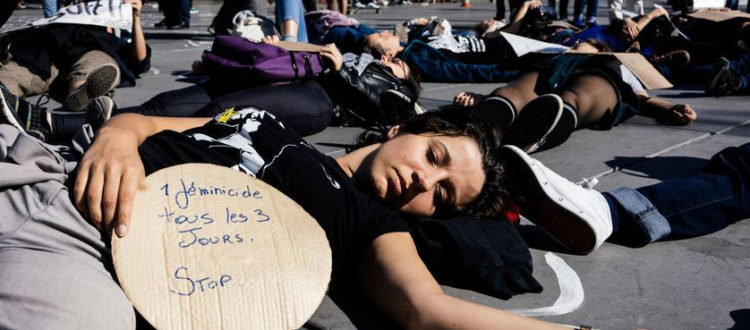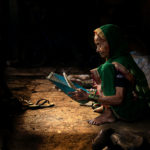Mots écrits
In France, on August 12, she was the 88th or maybe the 89th victim. She was 71 years old. There is no age limit to being killed by your partner, husband or ex. There are now 101 women victims of feminicide since January and the death toll will continue to grow. The epidemic is worldwide and almost permanently active. In France the government declared its intention to organize a conference in September to address the issue widely but failed to announce more funding. Compared to the 200 million euros Spain devoted for a national pact against domestic violence that is also called machismo terrorism, France scores poorly with its promised 79 million euros. It is time to face the reality of feminicide in France, and elsewhere.
The theatrical project Mots Ecrits, conceptualized by the actress Sophie Bourel from a collection of archives on women’s lives, makes visible invisibilized violence against women. Bourel decided that the first part of her project will concern the issue of feminicides, an issue that brings the everlasting danger for women of being killed as well as a sense of urgency. For Mots Ecrits, Bourel collects a corpus of archives on feminicides and creates a theatrical performance based on these written words. With a wide variety of documents, what she calls “de la matière” (raw material), she is able to give life to the words to make the performance live fully and independently.
Sophie Bourel feels that she has an enormous responsibility since feminicide still ravages society. When we met her one morning, she was all excited because she received documents from the archives of a French department. She welcomed us with “Hello I am so happy,” as if she had found a treasure. In fact, for her it was a treasure, since finding anything about women including about their assassination by partners, lovers etc. is so difficult. The invisibility of women is multifaceted and the invisibility of their elimination is at the source of their absence in public space. The files she received that morning concerned a crime that occurred January 16, 1975 in a French town on the Loire river. The woman killed that day first appeared in police records in July 1968. She went to the police station to report violence in her home and her son had a head injury; her neighbor also testified. This ended up in a murder attempt in June 1975, when the perpetrator raped and locked her up. She filed a complaint and got an apartment to which she moved with her children. But she was not safe. At the end of 1975, he visited her. She went to the police station to say that she was scared. On January 16, 1976, he waited outside her apartment building, grabbed her, dragged her to the riverbank and shot her twice.
Sophie Bourel doesn’t see this as an isolated case. She created a list of 78 and then 80 graves. She says, “If I look at my list, I am going to find a woman who has been killed in a similar way: 2 pistol or gun shots! I am going to put the two women in contact with one another to create a sort of echo, the one who died 50 years ago with the one who died in 2019. Killed in the same manner. It is as if one opened her casket to welcome the newly killed.” She adds that it is also a way to fight because we must fight, for if we don’t, nothing will happen to save women. Men should be afraid of killing women.
Within the archive she received, there was also a petition sent to Francoise Giroud, Secretary of State in charge of the condition of women from 1974 to 1976, the first ever ministry established in France that concerned women’s issues The text said:
Reasons for the choice of this type of petition:
The Judicial procedures and the possibilities of intervention of the bodies in charge of people’s safety seem to be able to work only after the crime has been committed. This procedure has the inconvenience of requiring the death of the person first before being able to activate the wheels of law. On the other hand, it has the advantage of not forcing the judges to make preventative decisions (that can be traumatic for the perpetrators).
This petition clearly shows the objectification of women and sadly points to the State as engendering such a view. Representation of human beings in the State means visibility and therefore the opportunity to be heard and seen. It means conferring the person or group with an identity, or a face. If a human being is not recognized by the State, that person is an object and can be killed. As Hannah Arendt points out, when people are objectified, they can be eliminated. Objectification of humans or the environment is the precondition to destruction. Conscience or ethical responsibility is tossed.
When Pramila’s mother, disabled and sick, was threatened by a family member, she had to get the help of police and lawyers. In one instance, the police said that she could be left alone with the violent family member. When Pramila objected that her mother is in danger of being hurt or even killed, the police responded, “Then we can bring a case against the perpetrator. No problem.” She was aghast. To even suggest that an old, ill and disabled woman should be killed in order to bring her perpetrator to justice is unconscionable.
When Nirbhaya’s rape, known as the Delhi rape case in 2012 led to mass movement for justice for women, a British journalist interviewed the rapists for the BBC. Recounting the incident in which Nirbhaya was sexually assaulted, one of the rapists, Singh, said “While being raped, she shouldn’t have fought back. She should have remained silent and allowed the rape.” We know that passivity would not have saved Nirbhaya’s life.
Worse yet is the law’s weakness when it comes to justice for women. Nirbhaya had to die after the gruesome mauling of her body in order for her case to go to the fast-track court! Alive, she had no protection against her assaulters.
French law has evolved very slowly, and has repeatedly failed to protect women. In March 1994, France introduced a series of laws against violence (in general), but it is only in 2003 that domestic violence is seen as an aggravating circumstance by the law. Since then, almost every year, a new amendment was passed in the desperate attempt to tackle the number of women killed by their partners and exes, but to no avail (articles 221-4222-12 and 222-13 of the French criminal code).
In comparison, in 2004 Spain reformed its criminal court system to bring down domestic violence, creating 106 specialized courts and an adapted prosecution bringing the rate of Spanish women killed by their husbands from 71 to 43. In Canada, because of the nature of the harm of domestic violence, the judges can provide for release conditions such as “no contact” until the trial or appeal even where no offence has been committed. Yet, where personal injury or damage is feared, courts can also order “peace bonds or recognizances.” The French Criminal laws also contain a number of special provisions that serve to protect victims, but these means are almost never used by the judges and the police.
How many women have to die in order to change the mentality about the role and rights of women? How many women have to show the scars, the badges of abuse, in order to be heard, and in order for the law to be comprehensively enforced? Laws regarding “national” security are immediately carried out and enforced! The urgency of the situation should have forced us to act a long time ago. Meanwhile, in France, 93 women have died since January 1st. Every week, 3 women are killed by their respective partners. For 3000 years women have been abused by men. In many countries, our laws have been written by men and (un)enforced by men. This is not acceptable.
(Photo Credit 1: France Culture / Denis Meyer / Hans Lucas / AFP)






